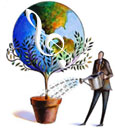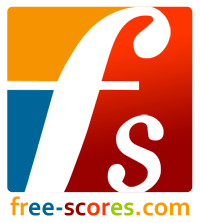

"For over 25 years we have provided legal access to free sheet music without asking anything in return.
If you use and like Free-scores.com, please consider making a donation. Your support will enable us to continue providing free scores to all."
 About free-scores.com / Member testimonies
About free-scores.com / Member testimonies
by MAGATAGAN, MICHAEL8x⬇ 3x
 | MP3 added the 2024-01-30 by magataganm |



Instrumentation
Winds and String OrchestraGenre
BaroqueArranger
• Editor
Copyright
Public Domain ↗Description
Dietrich Buxtehude is probably most familiar to modern classical music audiences as the man who inspired the young Johann Sebastian Bach to make a lengthy pilgrimage to Lubeck, Buxtehude's place of employment and residence for most of his life, just to hear Buxtehude play the organ. But Buxtehude was a major figure among German Baroque composers in his own right. Though we do not have copies of much of the work that most impressed his contemporaries, Buxtehude nonetheless left behind a body of v...
Dietrich Buxtehude is probably most familiar to modern
classical music audiences as the man who inspired the
young Johann Sebastian Bach to make a lengthy
pilgrimage to Lubeck, Buxtehude's place of employment
and residence for most of his life, just to hear
Buxtehude play the organ. But Buxtehude was a major
figure among German Baroque composers in his own right.
Though we do not have copies of much of the work that
most impressed his contemporaries, Buxtehude
nonetheless left behind a body of vocal and
instrumental music which is distinguished by its
contrapuntal skill, devotional atmosphere, and raw
intensity. He helped develop the form of the church
cantata, later perfected by Bach, and he was just as
famous a virtuoso on the organ.
In this cantata Buxtehude sets the sixth and seventh
verses of the chorale "Christe, du bist der helle Tag",
by Erasmus Alberus. The cantata is scored for soprano,
alto, tenor, bass, two violins, violone, and continuo.
As in many other cantatas with this scoring, Buxtehude
places the melody of the chorale he uses in the
soprano. The four-voice choir always sings as a unit;
there are no sections of the cantata written for a
soloist. Buxtehude ornaments the melody of the chorale
a bit more than in many of his other cantatas with the
same scoring, and changes the metric organization of
the chorale tune from duple to triple time to separate
the two verses of the chorale. He also concludes the
cantata with a rich polyphonic Amen.
Source: AllMusic
(https://www.allmusic.com/composition/befiehl-dem-engel
-dass-er-komm-for-satb-voices-2-violins-violone-continu
o-buxwv-10-mc0002384791).
Although originally composed for Chorus (SATB), 2
Violins, Violone & Continuo, I created this
Interpretation of "Befiehl dem Engel daß er komm'"
(Command the angel to come BuxWV 10) for Winds (Flute,
Oboe, French Horn & Bassoon) and Strings (2 Violins,
Viola & Cello).

We value your opinion
Help us improve the new version of Free-Scores.com
How would you rate the new version?
Thank you for your feedback!
Your feedback has been sent to our team.
It will help us improve Free-Scores.com.




